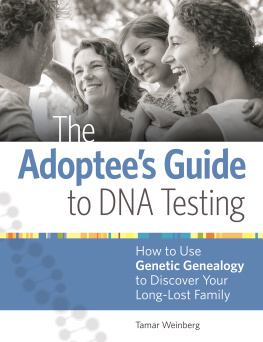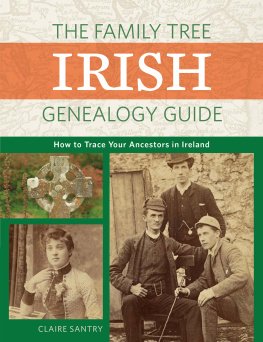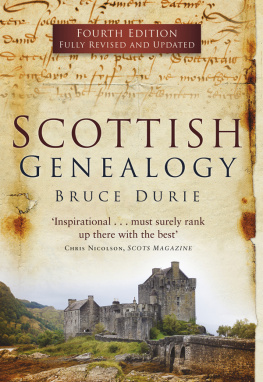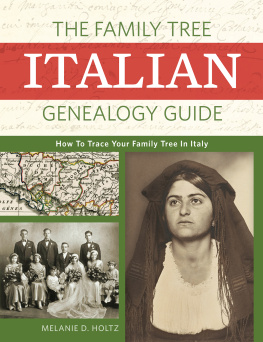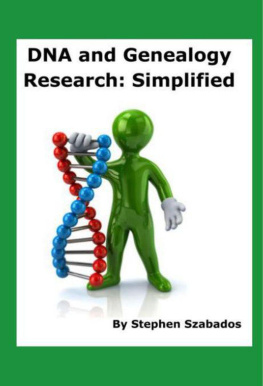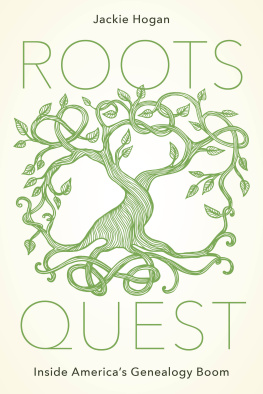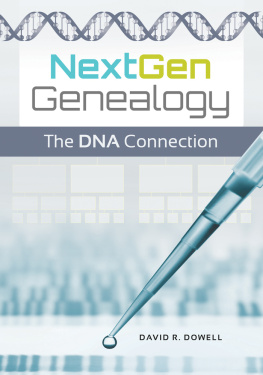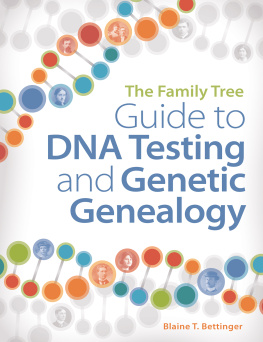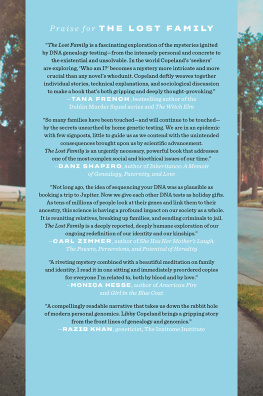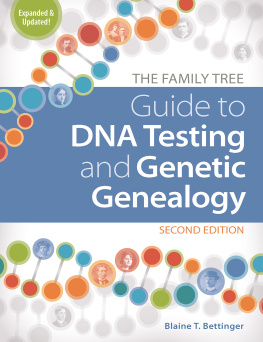Contents
Guide
The
Adoptees Guide
to DNA Testing
How to Use Genetic Genealogy to Discover Your Long-Lost Family
Tamar Weinberg

Cincinnati, OH
familytreemagazine.com/store
Dedication
This book is dedicated to my ancestors and descendants, my incredibly supportive husband Brian, and my four beautiful children, David, Sarah, Alana, and Danny. To Mom and Dad, Grandma and Grandpa, and the multitude of uncles, aunts, and cousins from near and far who gave me their tests to analyze further which gave me many different perspectives on DNA and where I came from. And finally, to Jackie Morris, whose relationship may never be determined, but who I know has some relationship to me somewhere. As far as Im concerned, youre my littlest sister even if we dont share full identical regions.
CONTENTS
Start your research right with these tips.
Before you turn to DNA, discover what resources such as adoption agencies, social media, and birth certificates can tell you about your biological families.
Understand the ABCs of DNA with this crash-course guide to the scientific principles of genetic genealogy.
Learn what DNA test is best for you with this wrap-up of the four major types of DNA tests: autosomal, X-chromosomal (X-DNA), Y-chromosomal (Y-DNA), and mitochondrial (mtDNA).
Join more than seven million users by testing at AncestryDNA, the worlds largest commercial DNA company. This chapter will show you how to navigate your results, from contacting matches to connecting your data to an online family tree.
Test multiple kinds of DNA at Family Tree DNA, the only major company to offer Y-DNA and mtDNA testing. Learn how to select the best test (and how to interpret your results) with this guide.
Access your DNA (as well as basic information about your medical history) with 23andMe. This chapter will show you how.
See what you can do with a DNA test from the online family tree giant MyHeritage DNA.
Reach out to potential relatives! This chapter will teach you how to use mirror trees to figure out how your genetic matches are related to you, plus share some tips for contacting them.
Take your research to the next level with the analysis tools at GEDmatch.
Pinpoint relatives on both sides of your family using DNA triangulation, an advanced technique for learning genetic information about a potential relative. This chapter will show you how.
Get motivated! These inspiring stories are real-life examples of how researchers used DNA to solve their family mysteries.
FOREWORD
I first encountered DNA and Mendelian theory in high school. Although my career was in technology (where the jobs were), I never stopped following the news about DNA. My husband likes to tell of his college-level biology textbook, which claimed DNA would never be sequenced. How wrong that was!
So here we are today with so many companies that will sample our personal DNA and give us reports. But which test should we use? Which company? When the price came down for personal DNA tests, I tested myself and many family members at 23andMe and then Family Tree DNA . Soon I was inundating my family with e-mails, which got no response.
Family secrets are being unearthed at an astounding rate, but most people have trouble understanding how to use DNA relative match results.
My solution was to start blogging in order to put all the information I was discovering in one place, in the hopes that some of these newfound relatives might access it someday. On the site, I included many how-to posts that I often shared in DNA mailing lists and Facebook groups. And since I am a programmer, I also wrote a few tools to help display and work with the segment match data.
Before long, I had thousands of unique visitors a day and had become an authority on the use of these tests for genealogy, a hobby I have enjoyed for much of my life. When people ask me how I became so knowledgeable on DNA, I tell them that if they were to spend three to four hours a day for five years working with their familys test results, they would become experts, too.
A few years ago, I met one of the founders of DNAAdoption.com at a conference where I was speaking. Her explanation of using DNA to find adoptees birth families fascinated me. Adoptees could use a common ancestral couple or two, then build their trees to find someone in the right place and time. And the shared matches tool at AncestryDNA and other sites provided unprecedented opportunities for adopteessometimes enough for those with deep American roots to trace their full ancestry.
The world of adoption searches has changed with the advent of DNA testing. Family secrets are being unearthed at an astounding rate, but most people have trouble understanding how to use DNA relative match results. Now that the database at AncestryDNA has more than seven million testers, many adoptees open their results there, discover a first cousin or close family DNA match, and barely feel the need to do anything further.
Soon I was taking the occasional adoption case and learning how to use technology to help with unknown parentage cases. And, through my blog, I have gotten to know many wonderful readers and adoptees, including Tamar Weinberg.
Tamar is from an endogamous group, Ashkenazi Jews, and has experience working through knotty DNA issues. Shes created this book, a great reference manual to help adoptees in their search and increase their understanding of DNA testing.
This book is an exhaustive compendium of the testing companies and tools availablesomething that is truly needed for unknown parentage searches, given that no one company or technique works for everyone. What tool is best depends on where your ancestors are from and whether they intermarried extensively (endogamy) or not.
I applaud Tamar for putting this together!
Kitty Munson Cooper
Genetic genealogy blogger
December 17, 2017
INTRODUCTION
Ive been fascinated with the idea of genealogy for as long as I can remember. As a teen during the dawn of the Internet age, I reached out to my familys designated genealogist, my second cousin once removed, Gary, to start a website where the family could meet, learn how they fit in the tree, and stay connected. That never happened, and while I thought about it on more than one occasion, I didnt pursue it. I merely observed Garys discoveries from the sidelines for years. He started doing genealogy research the same year I was born, so I didnt really think I could catch up.
This book strives to be a resource for those facing tough challenges in their genealogical research: specifically, those who were adopted or (for whatever) reason dont know one or both of their birth parents.
When I was fourteen, Gary self-published a book on our family. I was mesmerized by it, but figured documenting those family relationships couldnt have been too hard. After all, my maiden namePalgonis a unique one, and my family already knew we were all related.
I didnt initially appreciate how hard it was for Gary to find all the records, thoughtheyre not so easy to find, and theyre all written in foreign languages. Plus, he did this before the digital era. Its amazing what he was able to accomplish before much of the information became available online.
While I was interested in family from a young age, my true passion for genealogy didnt really get ignited until I turned thirty-five. Thanks to social media (especially Facebook), I saw that friends were trying to find family members through the site. One friend in particular, Alan, was often posting to a Jewish genealogy group.

